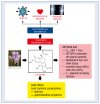Colchicine - From rheumatology to the new kid on the block: Coronary syndromes and COVID-19
- PMID: 34642922
- PMCID: PMC10129269
- DOI: 10.5603/CJ.a2021.0123
Colchicine - From rheumatology to the new kid on the block: Coronary syndromes and COVID-19
Abstract
Colchicine is an effective anti-inflammatory agent used to treat gout, coronary artery disease, viral pericarditis, and familial Mediterranean fever. It has been found to act by preventing the polymerization of the protein called tubulin, thus inhibiting inflammasome activation, proinflammatory chemokines, and cellular adhesion molecules. Accumulating evidence suggests that some patients with coronavirus disease 2019 (COVID-19) suffer from "cytokine storm" syndrome. The ideal anti-inflammatory in this setting would be one that is readily available, cheap, orally administered, with a good safety profile, well- tolerated, and that prevents or modulates inflammasome activation. The researchers selected colchicine for their study. This paper is a review of the literature describing the effects of colchicine, which is a drug that is being increasingly used, especially when standard therapy fails. Colchicine was shown to reduce inflammatory lung injury and respiratory failure by interfering with leukocyte activation and recruitment. In this publication, we try to systematically review the current data on new therapeutic options for colchicine. The article focuses on new data from clinical trials in COVID-19, rheumatic, cardiovascular, and other treatment such as familial Mediterranean fever, chronic urticaria, and PFAPA syndrome (periodic fever, aphthous, stomatitis, pharyngitis, and cervical adenitis). We also summarize new reports on the side effects, drug interactions, and safety of colchicine.
Keywords: COVID-19; cardiovascular diseases; colchicine; rheumatic diseases.
Conflict of interest statement
Figures




Similar articles
-
Gray zone in the spectrum of autoinflammatory diseases: familial Mediterranean fever accompanying periodic fever, aphthous stomatitis, pharyngitis, and adenitis syndrome: single-center experience.Eur J Pediatr. 2023 Dec;182(12):5473-5482. doi: 10.1007/s00431-023-05209-4. Epub 2023 Sep 30. Eur J Pediatr. 2023. PMID: 37777601
-
Does having MEFV gene sequence variants affect the clinical course and colchicine response in children with PFAPA syndrome?Eur J Pediatr. 2023 Jan;182(1):411-417. doi: 10.1007/s00431-022-04709-z. Epub 2022 Nov 15. Eur J Pediatr. 2023. PMID: 36376520 Free PMC article.
-
Is colchicine more effective to prevent periodic fever, aphthous stomatitis, pharyngitis and cervical adenitis episodes in Mediterranean fever gene variants?Pediatr Int. 2017 Jun;59(6):655-660. doi: 10.1111/ped.13265. Epub 2017 Apr 24. Pediatr Int. 2017. PMID: 28207965
-
Familial Mediterranean fever and periodic fever, aphthous stomatitis, pharyngitis, and adenitis (PFAPA) syndrome: shared features and main differences.Rheumatol Int. 2019 Jan;39(1):29-36. doi: 10.1007/s00296-018-4105-2. Epub 2018 Jul 17. Rheumatol Int. 2019. PMID: 30019226 Review.
-
IL-1β blockade in periodic fever, aphthous stomatitis, pharyngitis, and cervical adenitis (PFAPA) syndrome: case-based review.Rheumatol Int. 2021 Jan;41(1):183-188. doi: 10.1007/s00296-019-04389-3. Epub 2019 Jul 19. Rheumatol Int. 2021. PMID: 31324971 Review.
Cited by
-
Colchicine-The Divine Medicine against COVID-19.J Pers Med. 2024 Jul 16;14(7):756. doi: 10.3390/jpm14070756. J Pers Med. 2024. PMID: 39064010 Free PMC article. Review.
-
Is colchicine the holy grail for treating inflammation and reducing cardiovascular risk?Int J Cardiol Cardiovasc Risk Prev. 2021 Aug 24;10:200106. doi: 10.1016/j.ijcrp.2021.200106. eCollection 2021 Sep. Int J Cardiol Cardiovasc Risk Prev. 2021. PMID: 35112118 Free PMC article. No abstract available.
-
Fibrinogen-to-albumin ratio predicts mortality in patients with diabetes mellitus and atherosclerotic cardiovascular disease.Front Endocrinol (Lausanne). 2025 May 29;16:1539114. doi: 10.3389/fendo.2025.1539114. eCollection 2025. Front Endocrinol (Lausanne). 2025. PMID: 40510491 Free PMC article.
-
The effect of colchicine on cancer risk in patients with immune-mediated inflammatory diseases: a time-dependent study based on the Taiwan's National Health Insurance Research Database.Eur J Med Res. 2024 Apr 22;29(1):245. doi: 10.1186/s40001-024-01836-1. Eur J Med Res. 2024. PMID: 38649928 Free PMC article.
-
The role of neutrophil extracellular traps and proinflammatory damage-associated molecular patterns in idiopathic inflammatory myopathies.Clin Exp Immunol. 2023 Jul 21;213(2):202-208. doi: 10.1093/cei/uxad059. Clin Exp Immunol. 2023. PMID: 37289984 Free PMC article.
References
-
- Montealegre-Gómez G, Garcia-Botero A, Cantini J, et al. Potential effect of colchicine in the prevention of acute respiratory distress syndrome (ARDS) in patients with Covid-19 infection. Int J Surg Surgical Tech. 2020;4:000146. doi: 10.23880/ijsst-16000146.. - DOI
-
- Dzieciatkowski T, Filipiak KJ. SARS-CoV-2 coronavirus — update 2021 on diagnostic tools, vaccinations, and drugs. PZWL Publishing House; Warsaw: 2021.
Publication types
MeSH terms
Substances
LinkOut - more resources
Full Text Sources
Medical

